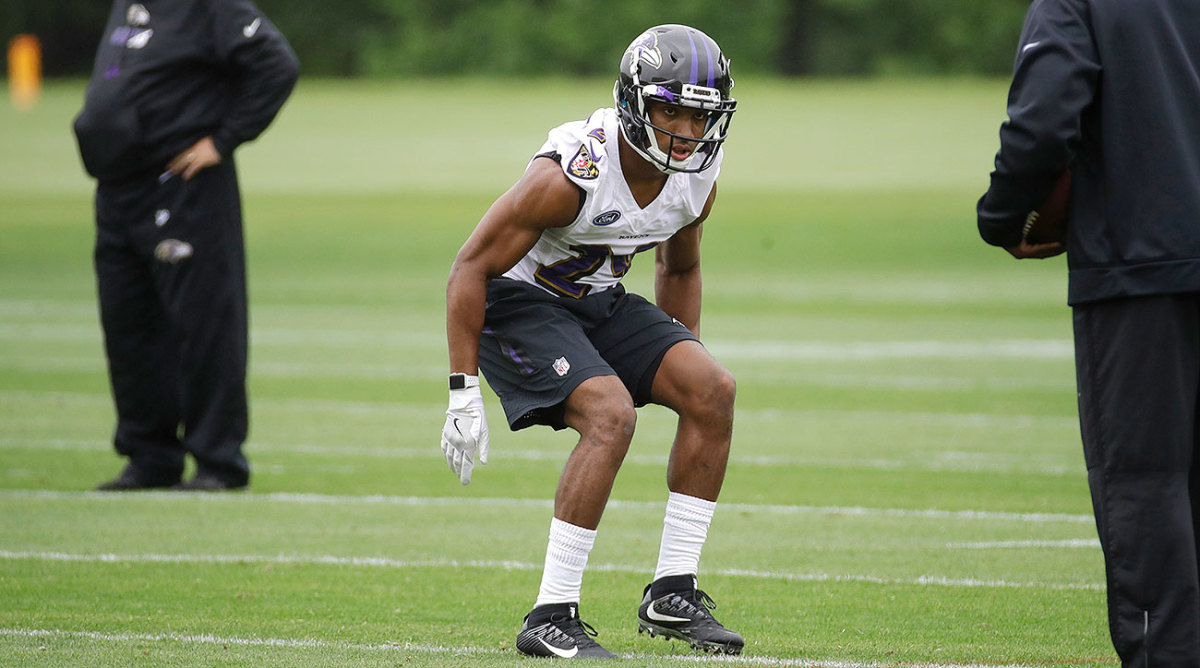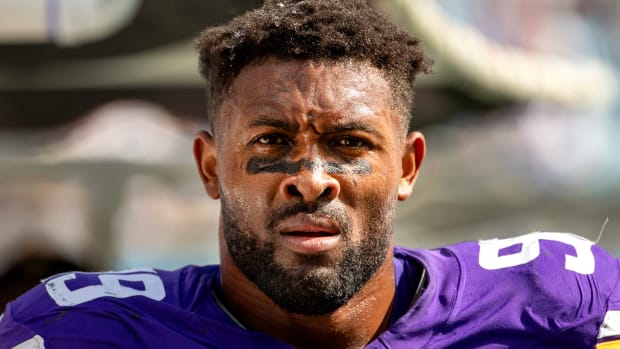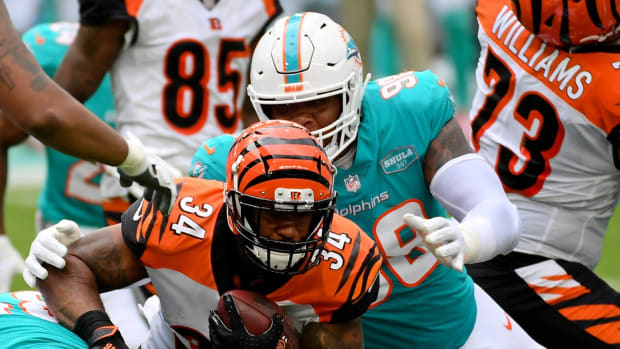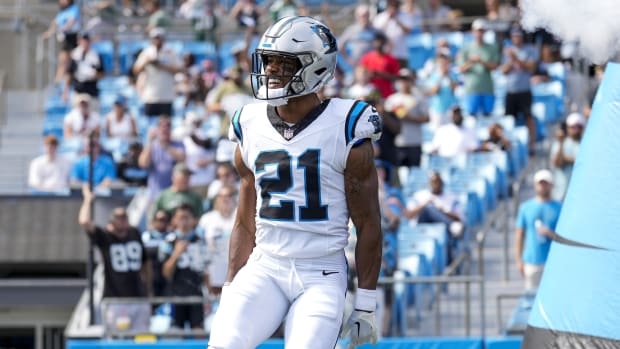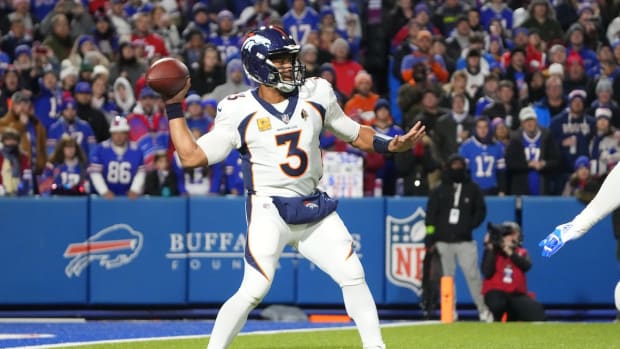Off-Season Report Cards: AFC North
BALTIMORE RAVENS
2016: 8–8, second in AFC North
Significant additions: CB Marlon Humphrey (R1), LB Tyus Bowser (R2), DT Chris Wormley (R3), CB Brandon Carr (FA), S Tony Jefferson (FA)
Significant losses: OT Ricky Wagner, CB Lardarius Webb, LB Elvis Dumervil, WR Kamar Aiken, S Matt Elam
Roster depth went from being Baltimore’s biggest strength to its greatest weakness in just five short years. Uncharacteristic failures in the draft for Ozzie Newsome and Eric DeCosta stunted efforts to replace defensive stalwarts like Ray Lewis and Ed Reed; of the team’s two first-round picks and four second-round picks between 2012 and ’14, just one remains on the roster (stud inside linebacker C.J. Mosely).
Yet Baltimore’s biggest handicap is one of its longest-tenured players. Joe Flacco, drafted in 2008, now carries the largest salary cap hit in football at $24.5 million in 2017. The Ravens are spending about 15% of their active cap space on a player with a 34–27 touchdown-interception ratio over the past two seasons. With the three-year extension he signed in 2016, Flacco can’t realistically be released and replaced until 2019, when the cap hit becomes more manageable.
“We need to get more out of Joe,” Ravens owner Steve Bisciotti said in January. “He would agree with me.”
What’s more, the Ravens did little to improve Flacco’s supporting cast this offseason. Baltimore lost superb right tackle Ricky Wagner to the Lions on a five-year, $47.5 million-dollar deal in free agency and wide receiver Steve Smith to retirement, adding only running back Danny Woodhead to the offense. All eyes are on third-year receiver Breshad Perriman and third-year tight end Maxx Williams, both of whom have missed significant time due to knee injuries.
Instead, the Ravens splurged on the defense. The team added versatile safety Tony Jefferson and capable cover corner Brandon Carr in free agency, and Newsome used his first four draft picks on the defense, addressing big needs at cornerback and outside linebacker with first-round choice Marlon Humphrey and second-rounder Tyus Bowser. It’s an embarrassment of riches for defensive coordinator Dean Pees, who built a defense around Mosely that ranked in the Top 10 in every meaningful statistical category in 2016.
Baltimore’s big problem remains a stagnant offense that only grew more conservative after the firing of offensive coordinator Marc Trestman after a Week 5 loss against Washington. Despite having the NFL’s eighth-ranked offensive line in terms of pass protection according to footballoutsiders.com, Flacco’s 6.4 yards per attempted were the lowest of his career. With former QB coach Marty Mornhinweg at the helm of the offense, Flacco leaned heavily on tight end Dennis Pitta, who last year was the third-most targeted tight end in the NFL but had just 729 yards receiving to show for it. However, the 31-year-old reinjured his hip at the Ravens’ OTAs, which means there’s a good chance Flacco may be losing last season’s receptions leader.
• OFF-SEASON REPORT CARDS: NFC East | NFC North | NFC South | NFC West
Baltimore’s check-down woes were never more apparent than in a Week 14 loss to the Patriots in Foxborough, when Flacco connected with running backs on 15 of his 37 completions to running backs, a season-high, while the Patriots seemed satisfied to drop seven or eight players into coverage.
Yet Mornhinweg returns, now armed with a full offseason to prepare. And the offense experienced only attrition in the meantime. If the answers are already on the roster, the time to reveal themselves is nigh.
Grade: C
* * *
CINCINNATI BENGALS
2016: 6-9-1, third in AFC North
Significant Additions: WR John Ross (R1), DE Jordan Willis (R3), RB Joe Mixon (R2), LB Kevin Minter (FA)
Significant Losses: LB Rey Maualuga, RB Rex Burkhead, LB Karlos Dansby, OT Andrew Whitworth, OG Kevin Zeitler, OT Eric Winston, DT Domata Peko, DE Margus Hunt
The exodus continues from Marvin Lewis’ Cincinnati Bengals.
A club that appeared on the cusp after a 12–4 finish in 2015 has seen the departure of several impact free agents in two years. After losing productive receivers Mohamed Sanu and Marvin Jones a year ago in free agency to the Falcons and Lions, respectively, offensive line centerpiece Eric Zeitler, one of the top guards in football, signed a five-year, $60 million deal with Cleveland this off-season. The loss of ageless wonder Andrew Whitworth, who took a three-year deal to anchor the Rams’ offensive line, leaves gaping holes, highlighting Cincinnati’s recent draft blunders.
Selecting tackles Cedric Ogbuehi and Jake Fisher back-to-back in rounds 1 and 2 in 2015 would have looked like a prescient move now, if not for their lackluster performances a year ago. Ogbuehi was a glorified turnstile at right tackle before switching to the left side—where he promptly allowed Jadaveon Clowney to put his left shoulder in QB Andy Dalton’s lumbar. Fisher, getting some late burn at right tackle, was similarly poor as a pass blocker.
So what did team president Mike Brown and Lewis do to stop the bleeding? After letting Whitworth and Zeitler walk they drafted 188-pound receiver John Ross in the first round and added running back Joe Mixon to a crowded position room. Now it’s up to Fisher and Ogbuehi to hold down the edges on an offense that appears to be squandering the best years of a seminal football talent in A.J. Green.
• Robert Saleh: His Road from 9/11 to the San Francisco 49ers
Despite losing aging-but-useful linebacker Karlos Dansby and serviceable interior lineman Domato Peko in free agency, Cincinnati’s defense remains formidable thanks to anchoring front seven performers Geno Atkins, Vontaze Burfict, Carlos Dunlap and Vinny Rey. Versatile safety Shawn Williams surprised as a more-than-capable replacement for Reggie Nelson (another 2016 defector).
The cornerbacks are another story. Dre Kirkpatrick and Darqueze Dennard have done little to justify their first-round selections in 2012 and ’14, underscoring Cincinnati’s biggest problem of late: Of the 17 players the team has drafted in the first three rounds after 2011 (the year they selected Green and Dalton), just one has made a Pro Bowl (Tyler Eifert in ’15). Zeitler certainly deserved a nod in 2016, but he’s no longer on the roster.
To hear Andrew Whitworth, the consummate team guy, talk about Cincinnati and his decision to join the Rams is to understand the pall that accompanied a 2016 regression into losing.
“I started to really open my eyes to man, what a challenge, and a new place, that would be something that invigorates me and makes me want to push even harder and do even more, find some other part of me that I don’t know exists that I can challenge myself to become,” Whitworth told ESPN in March. “And that’s what really intrigued me about the move.
“And then when I realized I was open to moving, and moving on to a new challenge, I really wanted to be away from Cincinnati’s situation.”
Look for that situation to change drastically if things don’t turn around in 2017.
Grade: D
* * *
CLEVELAND BROWNS
2016: 1–15, fourth in AFC North
Significant Additions: C JC Tretter (FA), OG Kevin Zeitler (FA), DE Myles Garrett (R1), SS Jabrill Peppers (R1), TE David Njoku (R1), WR Kenny Britt (FA)
Significant Losses: QB Robert Griffin III, WR Andrew Hawkins, QB Josh McCown, DB Tramon Williams, WR Terrelle Pryor, DT Stephen Paea, S Jordan Poyer
First- and second-round picks Myles Garrett and Jabrill Peppers add some much needed oomph to a run defense which gave up 4.6 yards per carry last season, but the big improvement here is along the offensive line, which has the chance to coalesce into something special.
Coach Hue Jackson, operating under the safe assumption that a powerful running offense and elite protection will make life easier for whoever is eventually tabbed as their starting quarterback, re-stocked an offensive line that produced 4.9 yards per carry a year ago with free agent additions J.C. Tretter at center and Eric Zeitler at guard. Tretter, 26, was playing the best football of his life in Green Bay last season before a knee injury cut his 2016 short. And Zeitler had emerged in Cincinnati as the top all-around guard in football in many eyes.
Put simply, it’s the Cowboys model; Take an outstanding offensive line, a 1,500 yard runner, and watch your rookie quarterback flourish. The Cowboys just happened to find the line, runner and QB in the span of six drafts and the Browns have been putzing around since choosing Joe Thomas to anchor the offensive line in 2007.
Obviously, Jackson would like to speed up the process, and despite a 1–15 finish, he seems to be identifying future long-term starters on both sides of the ball at a faster rate than his predecessors. Weakside linebacker Chris Kirksey and cornerback Jamar Taylor each offered promising performances for a defense that gave up the second-most yards in the NFL in 2016. Joel Bitonio, 25, was back in 2014 form until an October Lisfranc injury ended his season.
Is the quarterback of the future on the roster yet? Jackson has to hope second-round pick Deshone Kizer puts a stop to the QB carousel that has defined the Browns for the last two decades and some change, but he has his detractors, who point to his on-field decision-making, inaccuracy (Kizer tossed at least one pick in 15 of 23 starts) and decision to leave school a year early. He’s a project, and one the Browns appear comfortable resting on the bench until the offense is good and ready for a daisy-fresh rookie.
The biggest marker for success in Browns-land this season will not be Kizer’s play, but the Year Two test for 2016 rookies Emmanuel Ogbah and Corey Coleman. Understandably, the 22-year-old Coleman struggled after breaking his hand in a September practice. The fact that Cleveland had four different passers throwing the ball with regularity last season didn’t help. Ogbah, 23, turned in 5.5 sacks in 16 starts at defensive end, but really struggled against the run despite the anchoring presence of Danny Shelton on the interior line.
As much as Browns fans would like to see some adequate quarterback play for once, this season should be about finding the right solutions for longterm success on the offensive line with two new high-profile starters, and finally putting an end to a porous run defense that has made Cleveland the AFC North’s doormat long before Jackson showed up. If those units can jell early, consider the 2017 offseason a success.
Grade: B+
* * *
PITTSBURGH STEELERS
2016: 11–5, first in AFC North
Significant Additions: DE Tyson Alualu (FA), WR JuJu Smith-Schuster (R2), OLB T.J. Watt (R1), RB James Conner (R3), CB Cameron Sutton (R3), CB Coty Sensabaugh (FA), WR Justin Hunter (FA)
Significant Losses: LB Lawrence Timmons, RB DeAngelo Williams, RB Karlos Williams
Last year, the Steelers’ off-season was defined by a rare and ill-advised free agency spend for TE Ladarius Green. This year, the franchise’s off-season will be remembered for the one big move they didn’t pull off.
When the Steelers let Lawrence Timmons walk in free agency, finding an inside linebacker to play opposite Ryan Shazier became top priority this off-season. But after Dont’a Hightower turned down a Pittsburgh offer that was reportedly better than New England’s offer, the Steelers are forced to lean on the unproven Vince Williams, a fifth-year veteran with 16 career starts, in the middle of the defense.
In some ways, the aggressive pursuit of Hightower belied Mike Tomlin’s next-man-up mantra and the Steelers’ general philosophy that the answer is most always already on the roster. To the extent that Williams understands this is unclear: “I am humbled,” Williams told reporters this month. “We had an opportunity to get some linebackers in free agency. We had an opportunity to draft a first-round linebacker. It shows the organization has a lot of confidence in me. It is the first time I have ever felt that way.”
The Steelers instead opted to spend that first-round pick on T.J. Watt, the heir apparent to 39-year-old James Harrison, who turned in five sacks last season for Pittsburgh. Two other crucial figures for the Steelers’ defense: Former first-round pick and OLB Bud Dupree showed flashes in his late-season return from September abdominal surgery, and defensive end Cameron Heyward—perhaps the most important figure of the front seven—is still recovering from a torn pectoral suffered early last season; his healthy return is as large a preseason benchmark as any for this defense.
In the draft, Pittsburgh worked to plug two big holes on offense. Not content to wait and see on the return of Martavis Bryant—suspended for the entire 2016 season for violating the league’s substance abuse policy—Steelers GM Kevin Colbert added receiver JuJu Smith-Schuster to a room that looked thin at times despite the emergence of second-year receiver Eli Rogers (Antonio Brown earned more targets than the rest of the wide receivers combined). In the third round, Colbert added Pittsburgh running back James Conner, who will compete for the No. 2 job vacated by DeAngelo Williams.
• "I know I'm on my last chance": Martavis Bryant opens up about his suspension
The biggest unknown for a team whose Pro Bowl quarterback turned 35 in March is in the defensive backfield, which was middling as a pass defense until running aground vs. the Patriots in Foxborough. Cornerback Justin Gilbert, a former first-round pick in Cleveland traded to Pittsburgh early last year for a sixth-round pick, was a miss, which the Steelers admitted when they cut him in February. It’s now up to second-year corner Artie Burns and second-year safety Sean Davis to justify the team spending first- and second-round picks on the backfield after playing reliable if not standout football in 2016.
Grade: B–
































